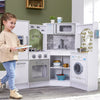Behind the Design Part 2: From Prototype to Playroom

Part 1 of Behind the KidKraft Design was all about the creative process of our toy and playset designs, from initial inspiration to mood boards and trend research. In Part 2, we’re focusing on what happens next: bringing those concepts to life through prototyping, collaboration and production.
Get ready to discover how sketches become computer-aided design (CAD) models, concepts evolve into real products and collaboration ensures every detail is just right before landing in your child’s hands.
Turning Playset Designs into Prototypes
How we design a playset starts with translating ideas into tangible form, and at KidKraft, structural design and mood board creation happen side by side. Early in the process, the team prepares for a concept approval meeting, where executives review CAD models or sketches alongside mood boards and “moments.” These “moments” are the small but memorable details—like a working elevator in a dollhouse or a cozy nook in a playset—that capture both the overall art style and the emotional feel of the design.
These checkpoints ensure that the product’s story is clear, the functionality makes sense, and the look ties back to the original inspiration. Style previews further bring the vision to life, helping the team visualize how these details will appear in a child’s world.



Hands-On Collaboration With Manufacturers
Prototyping is only the beginning. From there, our designers work in close partnership with manufacturers in China and Taiwan to bring each concept to life with precision. This collaboration allows us to maintain meticulous control over details that many brands overlook, such as color consistency, texture and gloss levels, making this approach truly unique to KidKraft.
The process is highly interactive: designers send Adobe Illustrator files overseas, manufacturers print and return samples, and the KidKraft team conducts rigorous checks to ensure every element matches the original vision. Even something as simple as a color swatch can go through multiple rounds of review before approval.
By carefully managing these details, we guarantee that every product, from dollhouses to playsets, looks and feels exactly as intended, right down to the smallest finish!
Testing, Feedback and Adjustments
Toy and playset design is a team effort, and not everyone involved speaks the same “design language.” Interpreting feedback from non-design stakeholders can sometimes pose challenges. But it’s all part of the process.
When feedback comes in, our designers collaborate across teams to rethink, rework and refine, whether it’s improving usability, enhancing safety or simplifying the assembly process for parents. The goal is always the same: a toy that delivers lasting fun while being safe, sturdy and easy to set up.
Designing for Longevity and Everyday Play
KidKraft goes well beyond chasing trends, making sure our designs are created with longevity in mind. Some dollhouse designs from 15–20 years ago are still in production today, loved by new generations of kids! At the same time, our team is just as excited about refreshing those legacy designs, breathing new life into classics so they feel modern, relevant and ready for years of play ahead.
We also love embracing new ideas, like designing kids’ furniture. This requires a different mindset that draws heavily on color, wood stain and natural fiber trends in exterior and landscape design. Our team is also working on outdoor products like playhouse and wooden playset designs, which bring in more architectural design elements along with updated stain and plastic colors.
With every new or updated design, our focus always remains on quality materials, timeless color palettes and durability that stands up to everyday play.
How Play Inspires Design Evolution
The most valuable insights come straight from the playroom. Our design team digs into customer reviews to better understand what families love—and where there’s room to improve. They also incorporate a hands-on research approach by regularly visiting homes to see how kids actually interact with toys in real life. These in-person observations and direct feedback loops often lead to meaningful innovations, such as the “open and closed” dollhouse concept, which was born from seeing the need for a toy that could double as storage. This gave kids more ways to play while offering parents a practical solution that keeps play areas tidy.
Blending imagination with functionality results in toys that are fun while also fitting seamlessly into family spaces. This immersive research process helps our team continuously improve designs and create toys that kids want to play with and parents want to buy.
Bringing It All Together: From Factory to Playroom
Once the design is finalized, it moves into full-scale production and quality assurance. Every detail is double-checked so families receive a product that’s safe, durable and true to KidKraft’s design vision.
For the design team, the most rewarding moment is seeing their work come to life in homes—knowing that what started as a sketch is now a centerpiece for play, learning and imagination!
Discover the Finished Designs
From bold ideas to beautifully crafted toys, every step of the KidKraft design journey leads to one thing: more imaginative play. Explore the full KidKraft collection, including play kitchens, dollhouses and activity tables, and see where creativity comes to life in your own home.














